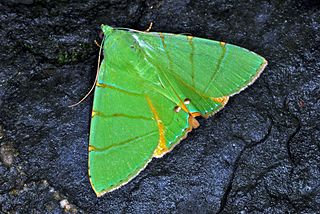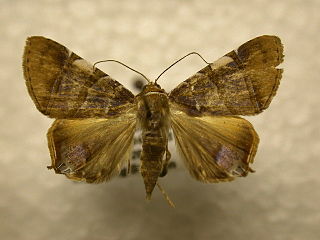
Eucereon is a genus of tiger moths in the family Erebidae. The genus was erected by Jacob Hübner in 1819.

Gymnelia is a genus of moths in the subfamily Arctiinae. The genus was erected by Francis Walker in 1854.

Loxophlebia is a genus of moths in the subfamily Arctiinae. The genus was erected by Arthur Gardiner Butler in 1876.

Macrocneme is a genus of tiger moths in the family Erebidae. The genus was erected by Jacob Hübner in 1818.

Virbia is a genus of tiger moths in the family Erebidae. The genus was erected by Francis Walker in 1854.

Eulepidotis is a genus of moths of the family Erebidae erected by Jacob Hübner in 1823.
Neumoegenia is a genus of moths of the family Noctuidae. The genus was erected by Augustus Radcliffe Grote in 1882.
Tarache is a genus of moths of the family Noctuidae erected by Jacob Hübner. It includes most former New World Acontia species. Lepidoptera and Some Other Life Forms and The Global Lepidoptera Names Index report this name as a synonym of Acontia.

Marblepsis is a genus of moths in the subfamily Lymantriinae. The genus was described by Hering in 1926.
Carmenta pallene is a moth of the family Sesiidae. It was described by Herbert Druce in 1889. It was described from Tabasco in Mexico, but it is also known from Arizona in the United States.

Eulepidotis alabastraria is a moth of the family Erebidae first described by Jacob Hübner in 1823. Many former members of the moth family Noctuidae are classified in the family Erebidae now, along with all of the former members of the families Arctiidae and Lymantriidae. This re-classification has not yet met with general consensus, and many resources and publications still follow the older classification scheme. It is found from the southern part of the United States to Central and South America.

Eulepidotis ezra is a moth of the family Erebidae first described by Herbert Druce in 1898. It is found in the Neotropics, including Mexico and Costa Rica.
Eulepidotis hemithea is a moth of the family Erebidae first described by Herbert Druce in 1889. It is found in the Neotropics, including Panama and Guyana.
Eulepidotis mustela is a moth of the family Erebidae first described by Herbert Druce in 1889. It is found in the Neotropics, including Mexico.
Eulepidotis nicaea is a moth of the family Erebidae first described by Herbert Druce in 1900. It is found in the Neotropics, including Colombia.
Eulepidotis primulina is a moth of the family Erebidae first described by Herbert Druce in 1900. It is found in the Neotropics, including Colombia.

Eulepidotis rectimargo is a moth of the family Erebidae first described by Achille Guenée in 1852. It is found in the tropics of the Western Hemisphere, including Mexico, Costa Rica, Guyana, Peru, Uruguay and Argentina. It was recorded from Texas by Ed Knudson and Charles Bordelon in 2004.
Apeplopoda mecrida is a moth of the family Erebidae. It was described by Herbert Druce in 1889. It found in the US state of Arizona, Mexico, Guatemala and Costa Rica.
Eucereon striata is a moth of the subfamily Arctiinae. It was described by Herbert Druce in 1889. It is found in Mexico, Costa Rica and Rio de Janeiro, Brazil.
Phoenicoprocta lydia, the Lydia tiger moth, is a moth in the subfamily Arctiinae. It was described by Herbert Druce in 1889. It is found in Mexico and southern Texas.










